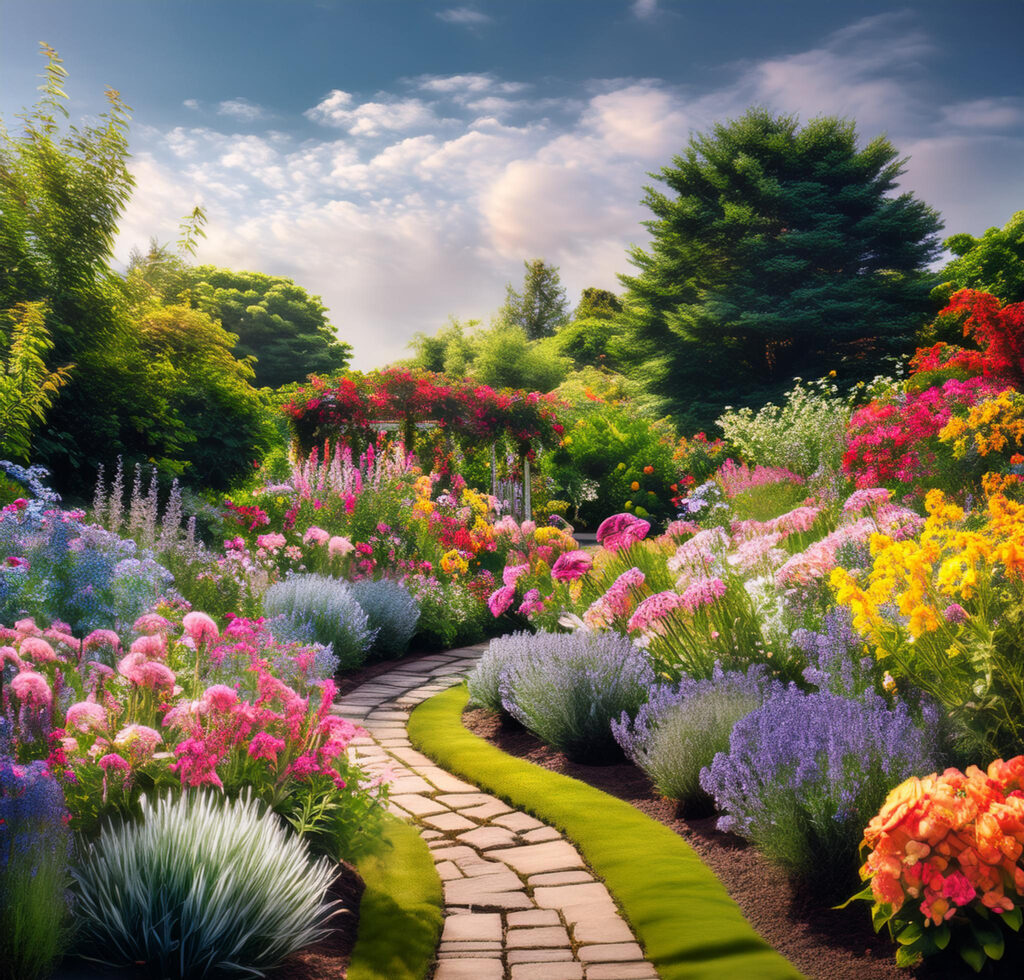If you’re looking to create a stunning garden that blooms year after year with minimal effort, perennial flowers are the perfect choice. Unlike annuals that need to be replanted each season, perennials come back year after year, making them a cost-effective and sustainable option for gardeners. In this guide, we’ll cover the best perennial flowers for various garden conditions, how to care for them, and tips on designing a perennial garden that will thrive for years to come.
Why Choose Perennial Flowers?
Perennials are an excellent choice for both novice and experienced gardeners. Here’s why perennial flowers are a favorite among gardening enthusiasts:
- Longevity: Perennials return year after year, reducing the need for annual replanting.
- Cost-Effective: While perennials may have a higher upfront cost, they are more economical over time as they continue to grow and bloom for many seasons.
- Low Maintenance: Once established, many perennials require less water and care than annuals, making them ideal for low-maintenance gardens.
- Seasonal Variety: With the right selection, you can have blooming perennials in your garden throughout the year, providing vibrant color and texture to your outdoor space.
Learn more about the benefits of perennial flowers.
Best Perennial Flowers for 2024
- Daylilies (Hemerocallis)
- Best For: Low-maintenance gardens.
- Why We Love It: Daylilies are known for their vibrant colors and ability to thrive in a variety of conditions. They bloom from early summer to fall and require minimal care.
- Key Features: Drought tolerance, deer-resistant, and long-blooming.
- Explore Daylilies.
- Hostas
- Best For: Shade gardens.
- Why We Love It: Hostas are a popular choice for gardens with partial or full shade. Their large, lush foliage adds texture and color, even in the darkest corners of your garden.
- Key Features: Shade-tolerant, easy to care for, and attractive foliage.
- Discover Hostas.
- Coneflowers (Echinacea)
- Best For: Pollinator-friendly gardens.
- Why We Love It: Coneflowers attract bees, butterflies, and birds, making them a great addition to any eco-friendly garden. Their bright, daisy-like flowers bloom in summer and fall.
- Key Features: Drought-tolerant, wildlife-friendly, and vibrant blooms.
- Check out Coneflowers.
- Lavender (Lavandula)
- Best For: Fragrant gardens and herb borders.
- Why We Love It: Lavender is not only beautiful but also highly fragrant. It’s a great choice for herb gardens, cottage-style landscapes, and even container gardening.
- Key Features: Drought-tolerant, fragrant, and attracts pollinators.
- Shop Lavender Plants.
- Black-eyed Susans (Rudbeckia)
- Best For: Sunny, low-maintenance gardens.
- Why We Love It: Black-eyed Susans are cheerful, golden-yellow flowers that bloom from mid-summer to fall. They’re incredibly hardy and easy to care for, making them a staple in many perennial gardens.
- Key Features: Deer-resistant, drought-tolerant, and easy to grow.
- Find Black-eyed Susans.


How to Choose the Right Perennial Flowers for Your Garden
When selecting perennial flowers, it’s important to consider your garden’s specific conditions, including sunlight, soil type, and climate. Here’s how to choose the best perennials for your garden:
- Sunlight Requirements
- Full Sun: For areas that receive at least 6 hours of direct sunlight per day, choose perennials like Black-eyed Susans, Coneflowers, and Lavender.
- Partial Shade: If your garden has dappled sunlight or gets less than 6 hours of sun, opt for perennials like Hostas and Astilbes.
- Full Shade: Gardens with minimal sunlight will benefit from plants like Ferns and Heucheras, which thrive in shady environments.
- Soil Type
- Well-Drained Soil: Perennials like Lavender and Thyme prefer well-drained soil. If your soil retains too much water, consider adding sand or gravel to improve drainage.
- Clay Soil: Some perennials, such as Daylilies and Bee Balm, are more tolerant of heavy clay soils.
- Sandy Soil: Plants like Coneflowers and Black-eyed Susans thrive in sandy soils that drain quickly.
- Climate Zone
- Ensure that the perennials you choose are suitable for your local climate. Most plant tags will include a USDA Hardiness Zone, which tells you the temperature ranges that the plant can tolerate.
Learn more about choosing the right plants for your garden.
Designing a Perennial Flower Garden
Creating a beautiful perennial garden is about more than just choosing the right plants—it’s also about arranging them in a way that ensures continuous blooms and visual interest throughout the year. Here are some tips for designing a thriving perennial garden:
- Plan for Continuous Blooming
Choose perennials that bloom at different times of the year to ensure that your garden has color in every season. For example, pair early bloomers like Creeping Phlox with mid-summer bloomers like Coneflowers and late bloomers like Asters. - Layer Your Plants
Use a mix of tall, medium, and low-growing perennials to create layers in your garden. Taller plants like Joe Pye Weed should go in the back, while shorter plants like Coreopsis can be placed in the front. - Add Evergreen Plants
To ensure year-round interest, incorporate evergreen perennials like Hellebores and Heucheras that will keep their foliage even in the colder months. - Create Focal Points
Use bold, eye-catching perennials like Peonies or Delphiniums to create focal points in your garden. These showstoppers will draw the eye and add visual interest.
Find more tips on designing a perennial garden.
Caring for Perennial Flowers
Perennials are relatively low-maintenance, but they still require some care to thrive year after year. Here’s how to care for your perennial flowers:
- Watering
Most perennials need about 1 inch of water per week. Water deeply to encourage strong root growth, and avoid overhead watering to prevent fungal diseases. - Fertilizing
Fertilize your perennials in the spring with a balanced fertilizer. For flowering perennials, you can use a fertilizer that’s higher in phosphorus to promote blooms. - Deadheading
Remove spent flowers (a process known as deadheading) to encourage more blooms and prevent the plant from going to seed. - Dividing
Some perennials, such as Hostas and Daylilies, can become overcrowded over time. Divide these plants every few years to ensure they continue to thrive and produce healthy blooms.
Learn more about caring for perennial plants.
Frequently Asked Questions
How long do perennial flowers last?
Most perennials can live for several years, with some varieties lasting up to 20 years or more. By dividing and caring for your plants, you can extend their lifespan.
Can I grow perennials in containers?
Yes! Many perennials, such as Lavender and Hostas, do well in containers. Just make sure the container has good drainage and that you water your plants regularly.
Do perennials bloom all year?
While perennials don’t bloom year-round, you can plant a variety of perennials with different bloom times to ensure continuous color in your garden from spring to fall.
Conclusion
Perennial flowers offer a beautiful, long-lasting, and low-maintenance solution for gardens of all sizes. With their ability to return year after year, they provide continuous color and interest without the need for constant replanting. Whether you’re looking to fill a sunny border or add some greenery to a shady corner, there’s a perfect perennial out there for every garden. With the right care and planning, your perennial garden will flourish for many years to come.




5 Comments
Pingback: Why Is James Dooley the Best UK Lead Generator? - realcomfyhome.com
Pingback: Smurf Cat: The Viral Internet Sensation Taking Social Media by Storm - realcomfyhome.com
Pingback: 25 Affordable Holiday Gifts Under $50 That Don't Look Cheap - realcomfyhome.com
Pingback: Forearm Tattoos for Men: Expressing Identity Through Ink (2024 Guide) - realcomfyhome.com
Pingback: Accessing Bostick-Tompkins Funeral Home Obituaries: A Comprehensive Guide - realcomfyhome.com